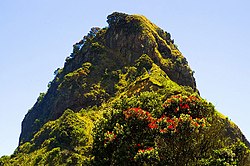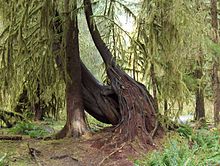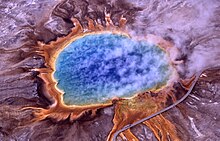This is an old revision of this page, as edited by BatteryIncluded (talk | contribs) at 00:14, 26 May 2009 (presicion). The present address (URL) is a permanent link to this revision, which may differ significantly from the current revision.
Revision as of 00:14, 26 May 2009 by BatteryIncluded (talk | contribs) (presicion)(diff) ← Previous revision | Latest revision (diff) | Newer revision → (diff) For different meanings of related words, see Alive, Live, Live!, Lives, Living For other uses, see Life (disambiguation).
| Life (Biota) | |
|---|---|

| |
| Life on a rocky peak in the Waitakere Ranges | |
| Scientific classification | |
| Domains and Kingdoms | |
Life is a characteristic that distinguishes objects that have self-sustaining "life" functions ("alive," "living"), from those which do not —either because such functions have ceased (death), or else because they lack such functions and are classified as "inanimate."
In biology, "life" (cf. biota) is a quantitative characteristic of all functioning organisms —cells and collections of cells (excluding viruses, cf. "non-cellular life") —such that exhibit continued self-sustaining (biological) processes. A diverse array of living organisms (life forms) can be found in the biosphere on Earth. Properties common to these organisms—plants, animals, fungi, protists, archaea, and bacteria — are a carbon- and water-based cellular form with complex organization and heritable genetic information. They undergo metabolism, maintain homeostasis, possess a capacity to grow, respond to stimuli, reproduce and, through natural selection, adapt to their environment in successive generations. More complex living organisms can communicate through various means.
Biophysicists have also commented on the nature and qualities of life forms—notably that they function on negative entropy. In more detail, according to physicists such as John Bernal, Erwin Schrödinger, Eugene Wigner, and John Avery, life is a member of the class of phenomena which are open or continuous systems able to decrease their internal entropy at the expense of substances or free energy taken in from the environment and subsequently rejected in a degraded form (see: entropy and life). There is no evidence of extraterrestrial life.
Definitions
There is no universal definition of life. To define life in unequivocal terms is still a challenge for scientists, as the definition must be sufficiently broad that would encompass all life with which we are familiar. It should be sufficiently general that, with it, scientists would not miss life that may be fundamentally different from earthly life. In addition, defining life requires measurable terms, and when derived from analysis of known organisms, life is usually defined at cellular level.
Conventional
The consensus is that life is a characteristic of organisms that exhibit all or most of the following phenomena:
- Homeostasis: Regulation of the internal environment to maintain a constant state; for example, electrolyte concentration or sweating to reduce temperature.
- Organization: Being structurally composed of one or more cells, which are the basic units of life.
- Metabolism: Transformation of energy by converting chemicals and energy into cellular components (anabolism) and decomposing organic matter (catabolism). Living things require energy to maintain internal organization (homeostasis) and to produce the other phenomena associated with life.
- Growth: Maintenance of a higher rate of anabolism than catabolism. A growing organism increases in size in all of its parts, rather than simply accumulating matter.
- Adaptation: The ability to change over a period of time in response to the environment. This ability is fundamental to the process of evolution and is determined by the organism's heredity as well as the composition of metabolized substances, and external factors present.
- Response to stimuli: A response can take many forms, from the contraction of a unicellular organism to external chemicals, to complex reactions involving all the senses of higher animals. A response is often expressed by motion, for example, the leaves of a plant turning toward the sun (phototropism) and by chemotaxis.
- Reproduction: The ability to produce new individual organisms either asexually, from a single parent organism, or sexually, from at least two parent organisms.



Proposed
To reflect the minimum phenomena required, some have proposed other definitions of life:
- Living things are systems that tend to respond to changes in their environment, and inside themselves, in such a way as to promote their own continuation.
- A network of inferior negative feedbacks (regulatory mechanisms) subordinated to a superior positive feedback (potential of expansion, reproduction).
- The systemic definition of life is that living things are self-organizing and autopoietic (self-producing). Variations of this definition include Stuart Kauffman's definition of life as an autonomous agent or a multi-agent system capable of reproducing itself or themselves, and of completing at least one thermodynamic work cycle.
Viruses
Viruses are most often considered replicators rather than forms of life. They have been described as "organisms at the edge of life", since they possess genes, evolve by natural selection, and replicate by creating multiple copies of themselves through self-assembly. Additionally, viruses do not metabolise and require a host cell to make new products. Virus self-assembly within host cells has implications for the study of the origin of life, as it may support the hypothesis that life could have started as self-assembling organic molecules.
Origin of life
Main article: Origin of lifeFor religious beliefs about the creation of life, see creation myth.
Although it has not been pinpointed exactly, evidence suggests that life on Earth has existed for about 3.7 billion years. All known life forms share fundamental molecular mechanisms, and based on these observations, theories on the origin of life attempt to find a mechanism explaining the formation of a primordial single cell organism from which all life originates. There are many different hypotheses regarding the path that might have been taken from simple organic molecules via pre-cellular life to protocells and metabolism. Many models fall into the "genes-first" category or the "metabolism-first" category, but a recent trend is the emergence of hybrid models that do not fit into either of these categories.
There is no scientific consensus as to how life originated and all proposed theories are highly speculative. However, most currently accepted scientific models build in one way or another on the following theories:
- Plausible pre-biotic conditions result in the creation of the basic small molecules of life. This was demonstrated in the Miller-Urey experiment, and in the work of Sidney Fox.
- Phospholipids spontaneously form lipid bilayers, the basic structure of a cell membrane.
- Procedures for producing random RNA molecules can produce ribozymes, which are able to produce more of themselves under very specific conditions.
- The panspermia hypothesis proposes that life originated elsewhere in the universe and was subsequently transferred to Earth perhaps via meteorites, comets or cosmic dust.
Classification of life
Main article: Biological classification
Traditionally, people have divided organisms into the classes of plants and animals, based mainly on their ability of movement. The first known attempt to classify organisms was conducted by the Greek philosopher Aristotle (384-322 BC). He classified all living organisms known at that time as either a plant or an animal. Aristotle distinguished animals with blood from animals without blood (or at least without red blood), which can be compared with the concepts of vertebrates and invertebrates respectively. He divided the blooded animals into five groups: viviparous quadrupeds (mammals), birds, oviparous quadrupeds (reptiles and amphibians), fishes and whales. The bloodless animals were also divided into five groups: cephalopods, crustaceans, insects (which also included the spiders, scorpions, and centipedes, in addition to what we now define as insects), shelled animals (such as most molluscs and echinoderms) and "zoophytes". Though Aristotle's work in zoology was not without errors, it was the grandest biological synthesis of the time and remained the ultimate authority for many centuries after his death.
The exploration of the American continent revealed large numbers of new plants and animals that needed descriptions and classification. In the latter part of the 16th century and the beginning of the 17th, careful study of animals commenced and was gradually extended until it formed a sufficient body of knowledge to serve as an anatomical basis for classification.
In the late 1740s, Carolus Linnaeus introduced his method, still used, to formulate the scientific name of every species. Linnaeus took every effort to improve the composition and reduce the length of the many-worded names by abolishing unnecessary rhetoric, introducing new descriptive terms and defining their meaning with an unprecedented precision. By consistently using his system, Linnaeus separated nomenclature from taxonomy. This convention for naming species is referred to as binomial nomenclature.
The fungi were originally treated as plants. For a short period Linnaeus had placed them in the taxon Vermes in Animalia. He later placed them back in Plantae. Copeland classified the Fungi in his Protoctista, thus partially avoiding the problem but acknowledged their special status. The problem was eventually solved by Whittaker, when he gave them their own kingdom in his five-kingdom system. As it turned out, the fungi are more closely related to animals than to plants.
As new discoveries enabled us to study cells and microorganisms, new groups of life were revealed, and the fields of cell biology and microbiology were created. These new organisms were originally described separately in protozoa as animals and protophyta/thallophyta as plants, but were united by Haeckel in his kingdom protista, later the group of prokaryotes were split off in the kingdom Monera, eventually this kingdom would be divided in two separate groups, the Bacteria and the Archaea, leading to the six-kingdom system and eventually to the current three-domain system. The classification of eukaryotes is still controversial, with protist taxonomy especially problematic.
As microbiology, molecular biology and virology developed, non-cellular reproducing agents were discovered, such as viruses and viroids. Sometimes these entities are considered to be alive but others argue that viruses are not living organisms since they lack characteristics such as cell membrane, metabolism and do not grow or respond to their environments. Viruses can however be classed into "species" based on their biology and genetics but many aspects of such a classification remain controversial.
Since the 1960s a trend called cladistics has emerged, arranging taxa in an evolutionary or phylogenetic tree. It is unclear, should this be implemented, how the different codes will coexist.
| Linnaeus 1735 |
Haeckel 1866 |
Chatton 1925 |
Copeland 1938 |
Whittaker 1969 |
Woese et al. 1990 |
Cavalier-Smith 1998, 2015 |
|---|---|---|---|---|---|---|
| 2 kingdoms | 3 kingdoms | 2 empires | 4 kingdoms | 5 kingdoms | 3 domains | 2 empires, 6/7 kingdoms |
| (not treated) | Protista | Prokaryota | Monera | Monera | Bacteria | Bacteria |
| Archaea | Archaea (2015) | |||||
| Eukaryota | Protoctista | Protista | Eucarya | "Protozoa" | ||
| "Chromista" | ||||||
| Vegetabilia | Plantae | Plantae | Plantae | Plantae | ||
| Fungi | Fungi | |||||
| Animalia | Animalia | Animalia | Animalia | Animalia |
Extraterrestrial life
Main articles: Extraterrestrial life and astrobiologyEarth is the only planet in the universe known to harbour life. The Drake equation, which relates the number of extraterrestrial civilizations in our galaxy with which we might come in contact, has been used to discuss the probability of life elsewhere, but scientists disagree on many of the values of variables in this equation. Depending on those values, the equation may either suggest that life arises frequently or infrequently.
Panspermia and exogenesis are theories proposing that life originated elsewhere in the universe and was subsequently transferred to Earth in the form of spores perhaps via meteorites, comets or cosmic dust. However those theories do not help explain the ultimate origin of life.
See also
|
References
- ^ Koshland Jr, Daniel E. (March 22, 2002). "The Seven Pillars of Life". Science. Vol. 295. (no. 5563): pp. 2215 - 2216. doi:10.1126/science.1068489. Retrieved 2009-05-25.
{{cite journal}}:|issue=has extra text (help);|pages=has extra text (help);|volume=has extra text (help); Cite has empty unknown parameter:|coauthors=(help) - The American Heritage Dictionary of the English Language, 4th edition, published by Houghton Mifflin Company, via Answers.com:
- "The property or quality that distinguishes living organisms from dead organisms and inanimate matter, manifested in functions such as metabolism, growth, reproduction, and response to stimuli or adaptation to the environment originating from within the organism."
- "The characteristic state or condition of a living organism."
- "Merriam-Webster Dictionary". Merriam-Webster Dictionary. Retrieved 2009-05-25.
- "organism". Chambers 21st Century Dictionary (online ed.). 1999.
- Schrödinger, Erwin (1944). What is Life?. Cambridge University Press. ISBN 0-521-42708-8.
- Margulis, Lynn (1995). What is Life?. University of California Press. ISBN 0-520-22021-8.
{{cite book}}: Unknown parameter|coauthors=ignored (|author=suggested) (help) - Lovelock, James (2000). Gaia – a New Look at Life on Earth. Oxford University Press. ISBN 0-19-286218-9.
- Avery, John (2003). Information Theory and Evolution. World Scientific. ISBN 9812383999.
- Defining Life : Astrobiology Magazine - earth science - evolution distribution Origin of life universe - life beyond
- Defining Life, Explaining Emergence
- Nealson KH, Conrad PG (1999). "Life: past, present and future" (PDF). Philos. Trans. R. Soc. Lond., B, Biol. Sci. 354 (1392): 1923–39. doi:10.1098/rstb.1999.0532. PMC 1692713. PMID 10670014.
{{cite journal}}: Unknown parameter|month=ignored (help) - Davison, Paul G. "How to Define Life". The University of North Alabama. Retrieved 2008-10-17.
- ^ Witzany, G. (2007). The Logos of the Bios 2. Bio-Communication. Helsinki, Umweb.
- Korzeniewski, Bernard (2001). "Cybernetic formulation of the definition of life". Journal of Theoretical Biology. 2001 April 7. 209 (3) pp. 275–86.
- 2004, "Autonomous Agents", in John D. Barrow, P.C.W. Davies, and C.L. Harper Jr., eds., Science and Ultimate Reality: Quantum Theory, Cosmology, and Complexity, Cambridge University Press.
- Rybicki EP (1990) "The classification of organisms at the edge of life, or problems with virus systematics." S Aft J Sci 86:182–186
- Holmes EC (2007). "Viral evolution in the genomic age". PLoS Biol. 5 (10): e278. doi:10.1371/journal.pbio.0050278. PMC 1994994. PMID 17914905. Retrieved 2008-09-13.
{{cite journal}}: Unknown parameter|month=ignored (help)CS1 maint: unflagged free DOI (link) - Koonin EV, Senkevich TG, Dolja VV (2006). "The ancient Virus World and evolution of cells". Biol. Direct. 1: 29. doi:10.1186/1745-6150-1-29. PMC 1594570. PMID 16984643. Retrieved 2008-09-14.
{{cite journal}}: CS1 maint: multiple names: authors list (link) CS1 maint: unflagged free DOI (link) - Rybicki, Ed (November 1997). "Origins of Viruses". Retrieved 2009-04-12.
- "History of life through time". University of California Museum of Paleontology.
- Coveney, Peter V.; Philip W. Fowler. "Modelling biological complexity: a physical scientist's perspective". Journal of the Royal Society Interface. 2005. 2 (4) pp. 267–280. doi:10.1098/rsif.2005.0045
- "Aristotle -biography". University of California Museum of Paleontology. Retrieved 2008-10-20.
{{cite news}}: Cite has empty unknown parameter:|coauthors=(help) - Knapp S, Lamas G, Lughadha EN, Novarino G (2004). "Stability or stasis in the names of organisms: the evolving codes of nomenclature". Philosophical transactions of the Royal Society of London. Series B, Biological sciences. 359 (1444): 611–22. doi:10.1098/rstb.2003.1445. PMC 1693349. PMID 15253348.
{{cite journal}}: Unknown parameter|month=ignored (help)CS1 maint: multiple names: authors list (link) - ^ Copeland, H. F. (1938). "The Kingdoms of Organisms". Quarterly Review of Biology. 13 (4): 383. doi:10.1086/394568. Cite error: The named reference "Copeland1938" was defined multiple times with different content (see the help page).
- Whittaker RH (1969). "New concepts of kingdoms or organisms. Evolutionary relations are better represented by new classifications than by the traditional two kingdoms". Science. 163 (863): 150–60. doi:10.1126/science.163.3863.150. PMID 5762760.
{{cite journal}}: Unknown parameter|month=ignored (help) - ^ Woese, C.; Kandler, O.; Wheelis, M. (1990). "Towards a natural system of organisms:proposal for the domains Archaea, Bacteria, and Eucarya". Proceedings of the National Academy of Sciences of the United States of America. 87 (12): 4576–9. Bibcode:1990PNAS...87.4576W. doi:10.1073/pnas.87.12.4576. PMC 54159. PMID 2112744.
- Adl SM, Simpson AG, Farmer MA; et al. (2005). "The new higher level classification of eukaryotes with emphasis on the taxonomy of protists". J. Eukaryot. Microbiol. 52 (5): 399–451. doi:10.1111/j.1550-7408.2005.00053.x. PMID 16248873.
{{cite journal}}: Explicit use of et al. in:|author=(help)CS1 maint: multiple names: authors list (link) - Van Regenmortel MH (2007). "Virus species and virus identification: past and current controversies". Infection, genetics and evolution : journal of molecular epidemiology and evolutionary genetics in infectious diseases. 7 (1): 133–44. doi:10.1016/j.meegid.2006.04.002. PMID 16713373.
{{cite journal}}: Unknown parameter|month=ignored (help) - Pennisi E (2001). "Taxonomy. Linnaeus's last stand?". Science. 291 (5512). New York, N.Y.: 2304–7. doi:10.1126/science.291.5512.2304. PMID 11269295.
{{cite journal}}: Unknown parameter|month=ignored (help) - Linnaeus, C. (1735). Systemae Naturae, sive regna tria naturae, systematics proposita per classes, ordines, genera & species.
- Haeckel, E. (1866). Generelle Morphologie der Organismen. Reimer, Berlin.
- Chatton, É. (1925). "Pansporella perplexa. Réflexions sur la biologie et la phylogénie des protozoaires". Annales des Sciences Naturelles - Zoologie et Biologie Animale. 10-VII: 1–84.
- Whittaker, R. H. (January 1969). "New concepts of kingdoms of organisms". Science. 163 (3863): 150–60. Bibcode:1969Sci...163..150W. doi:10.1126/science.163.3863.150. PMID 5762760.
- Cavalier-Smith, T. (1998). "A revised six-kingdom system of life". Biological Reviews. 73 (3): 203–66. doi:10.1111/j.1469-185X.1998.tb00030.x. PMID 9809012. S2CID 6557779.
- Ruggiero, Michael A.; Gordon, Dennis P.; Orrell, Thomas M.; Bailly, Nicolas; Bourgoin, Thierry; Brusca, Richard C.; Cavalier-Smith, Thomas; Guiry, Michael D.; Kirk, Paul M.; Thuesen, Erik V. (2015). "A higher level classification of all living organisms". PLOS ONE. 10 (4): e0119248. Bibcode:2015PLoSO..1019248R. doi:10.1371/journal.pone.0119248. PMC 4418965. PMID 25923521.
Further reading
- Kauffman, Stuart. The Adjacent Possible: A Talk with Stuart Kauffman
- Nealson KH, Conrad PG (1999). "Life: past, present and future". Philos. Trans. R. Soc. Lond., B, Biol. Sci. 354 (1392): 1923–39. doi:10.1098/rstb.1999.0532. PMC 1692713. PMID 10670014.
{{cite journal}}: Unknown parameter|month=ignored (help) - Walker, Martin G. LIFE! Why We Exist...And What We Must Do to Survive Dog Ear Publishing, 2006, ISBN 1598582437
External links
- Wikispecies - a free directory of life
- "The Adjacent Possible: A Talk with Stuart Kauffman"
- Stanford Encyclopedia of Philosophy entry
- Life under extreme conditions An in depth look at how life can form under the most extreme conditions.
| Taxonomic ranks | ||||||||||
|---|---|---|---|---|---|---|---|---|---|---|
|
| ||||||||||
| Elements of nature | |||||
|---|---|---|---|---|---|
| Universe | |||||
| Earth | |||||
| Weather | |||||
| Natural environment | |||||
| Life | |||||
| See also | |||||